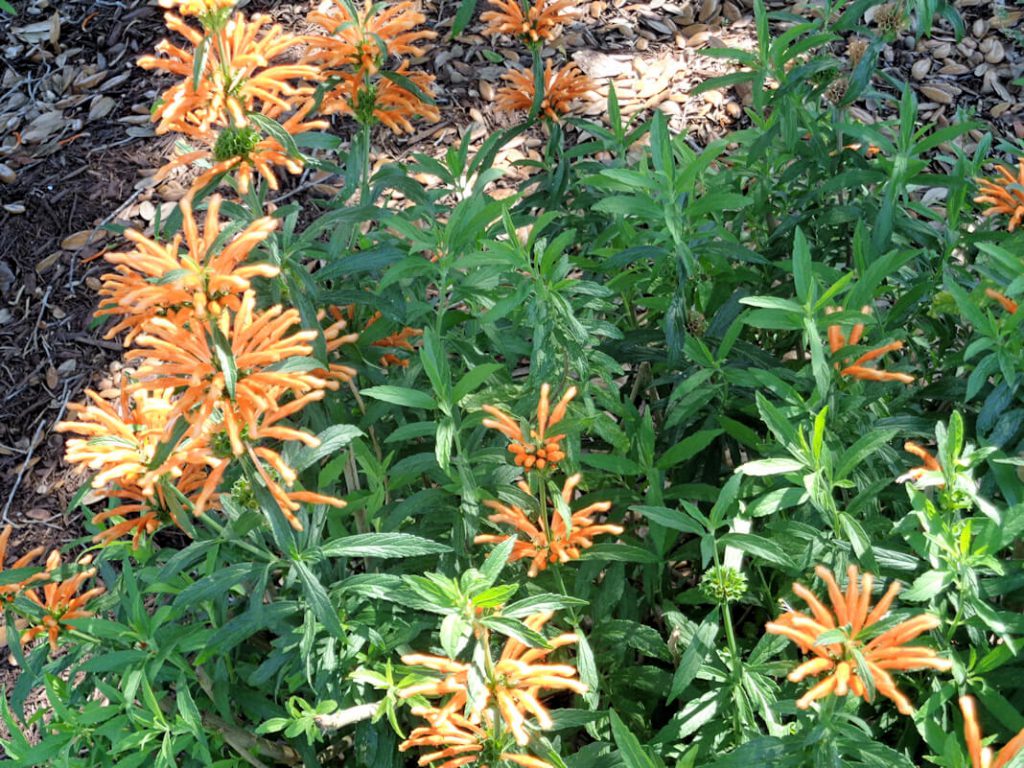
Bringing you back to the Nature Park in Punta Gorda, I wanted to introduce (or reintroduce) an underutilized perennial that fits into Florida-Friendly Landscaping™, has bright orange flowers from summer on through early winter and was even a 2004 Florida Nurserymen and Growers Association Plant of the Year! The lion’s ear, aka lion’s tail, may be the plant for you. Not that easy to find locally, it is a good sustainable landscape plant that will fit into everyone’s yard.
The lion’s ear is a perennial shrub originally from southern Africa that can grow up to five feet tall and three-foot wide. Ball-like, whorled clusters of bright orange tubular flowers are arranged on a square-stemmed stalk, one on-top of another. These tubular flowers are very hairy on the outside and have taken on the name lion’s ear for that reason. Lion’s ear is in the mint family known for its square-shaped stems (when cut in cross section) and mildly aromatic foliage with an almost chrysanthemum scent.
This flowering perennial plant is very drought tolerant when established and is ideal for Florida-Friendly Landscaping™. As a matter of fact, make sure that it has a well-drained site in full sun and do not overwater. You can start this plant from seed, or it can be propagated from a softwood cutting. Lion’s ear is ideal for coastal gardens as it is pretty salt tolerant. This is a vigorous growing plant that works well in mass plantings and is nicely complimented when planted with flowers such as salvias. Lion’s ear is a butterfly, hummingbird and bee favorite, so include it in your butterfly garden as a nectar source. This interesting, multi-purposed flower can be used as fresh cut flowers or in dried arrangements.
While orange-colored flowers are most popular, there is a white-flowering cultivar called ‘Harrismith White’ if you wanted a different color theme. I have seen the lion’s ear called big, beautiful and as tough as nails. As such, don’t be afraid of pruning clumps of lion’s ears back from time to time to clean out old, woody stems and reinvigorate new growth.
Just a note of caution – don’t confuse this species with another – Leonotis nepetifolia. Leonotis nepetifolia can be found as an escape in disturbed natural areas in Florida. This species has larger leaves and less attractive flowers.
While the Nature Park has a nice planting of lion’s ears – which I encourage you to visit – where do you find this perennial for sale? It is one of those plants you might call a “passalong “plant where you root a cutting and pass it along to another gardener. Or, just put “Lion’s Ears for sale” in an Internet search engine and you are likely to find many mail-order sources. Whether from a friend, or a distant source, find a lion’s ear and start growing a perennial you will truly love for years! For more information on all types of perennial flowers suitable for our area, or to ask a question, please visit https://www.facebook.com/CharlotteMGLifeline/ . Ralph E. Mitchell is the Director/Horticulture Agent for the UF/IFAS Charlotte County Extension Service. He can be reached at 941-764-4344 or ralph.mitchell@charlottecountyfl.gov.
Resources:
Christman, S. (2009) Leonotus leonurus. Floridata.com, Tallahassee, Florida.
(2004) 2004 Plants of the Year. Florida Nurserymen & Growers Association
Passalong Plants (2013) UF/IFAS Gardening Solutions – The University of Florida, IFAS.
Lion’s Ear (2019) UF/IFAS Gardening Solutions – The University of Florida, IFAS.
Center For Aquatic And Invasive Plants (2021) Leonotis nepetifolia. The University of Florida, IFAS.
UNF Landscape (2021) Leonotus leonurus – Lion’s Tail.
Leonotus leonurus. (2021) Missouri Botanical Garden.
The Florida-Friendly Landscaping Guide to Plant Selection & Landscape Design (2010) The University of Florida Extension Services, IFAS.
 2
2

Comments are closed.